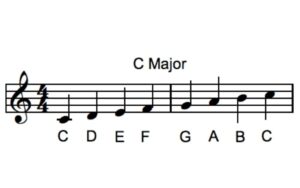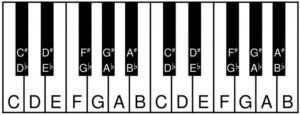Pitch
To make a sound, a vibration must be caused in the air. This can be done, for example, by a string or the skin of a drum. If this vibration is fast, we hear it as a high pitch. If it is slow, we hear it as low or deep pitch. The human ear can pick up a pitch from 16-20 vibrations per second and the upper threshold is about 20 000. As we get older, this number decreases.
A choir made of adults has a range of 64 to 1 500 vibrations – in general.
There are standardized pitches, like the “A” that makes 440 cycles per second.
Musical notation
In music seven letters are used for different pitches, from A to G. When you play the white keys on a piano from A to G, you covered an octave. If you continue, you hear the same notes, just a higher version of them.
Note, pitch and staff
To graphically symbolize a pitch, we use notes. When the notes are combined in an intelligent way, they form melodies.
The notes are put on a five lines staff or stave. At the beginning of each staff a sign called clef shows if those lines are treble or bass notes. A pianist uses both (as left and right hand), a violinist typically uses the treble part.

If the composer wishes to make a smaller step between two notes (not a full tone), a sharp or a flat sign is used. Sharp means raise the note by a semitone, flat means lowering by a semitone. This way, G-sharp and A-flat is the same tone.
Intervals
Intervals are gaps between notes. Some instruments can only make steps between notes, like a piano, others can do more fine increments. Such example can be the violin or the human voice.
Harmony
When notes are combined, we call it harmony, and these played simultaneously, form a chord. A chord can be dissonant or consonant (harmonious).
Tempo and rhythm
Positioning notes in time and the duration of the notes creates rhythm. Sound and silence are the terms used for the duration, where sound is a note and silence is a rest.
The beat (unit of time), or rather its speed, is the tempo of a music. Composers before the metronome used Italian expressions for indicating the tempo.
Grave – slow (solemn) (20–40 BPM)
Lento – slowly (40–45 BPM)
Largo – broadly (45–50 BPM)
Adagio – slow (literally, “at ease”) (55–65 BPM)
Adagietto – rather slow (65–69 BPM)
Andante – at a walking pace (73–77 BPM)
Moderato – moderately (86–97 BPM)
Allegretto – moderately fast (98–109 BPM)
Allegro – fast and bright (109–132 BPM)
Vivace – lively and fast (132–140 BPM)
Presto – extremely fast (168–177 BPM)
Prestissimo – as fast as possible (178 BPM and over)
Dynamics
The intensity (or volume) of a sound will define the dynamics. Just as with tempo, Italian words are associated with dynamics.
Pianissimo (pp) – very quiet
Piano (p) – quiet
Mezzo forte (mf) – moderately loud
Forte (f) – loud
Fortissimo (ff) – very loud
Sforzando (sfz) – a sudden, forced loud
Crescendo (cresc) – gradually getting louder
Diminuendo (dim) – gradually getting quieter
Metre
We use time signature to indicate the metre. In a ¾ time, for example, the upper number shows the beats in a bar, the lower number shows the value of each beat.
Scales
Notes in a certain sequence order is the scale. For example: do, re, mi, fa, sol, la, ti, do. The distances in this sequence are: tone, tone, semitone, tone, tone, tone, semitone. This scale is called a major scale and humans associate positive feelings with it.

The minor scale, is formed following this sequence: tone, semitone, tone, tone, semitone, tone, tone… and repeating the cycle. The minor scale is often associated with sad or tragic moods.










